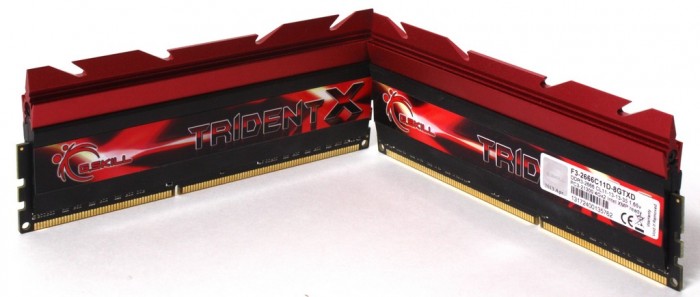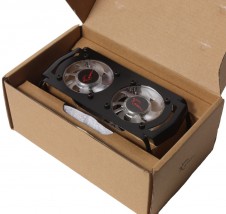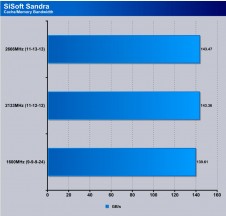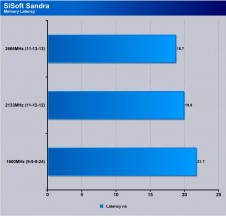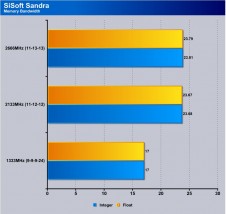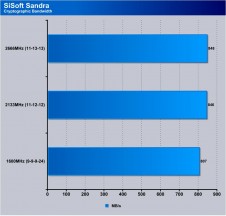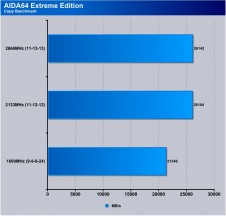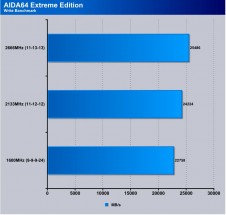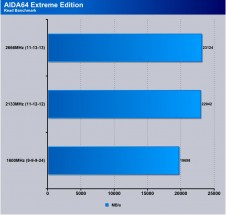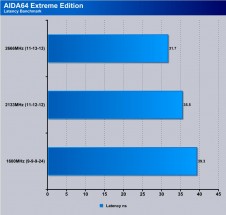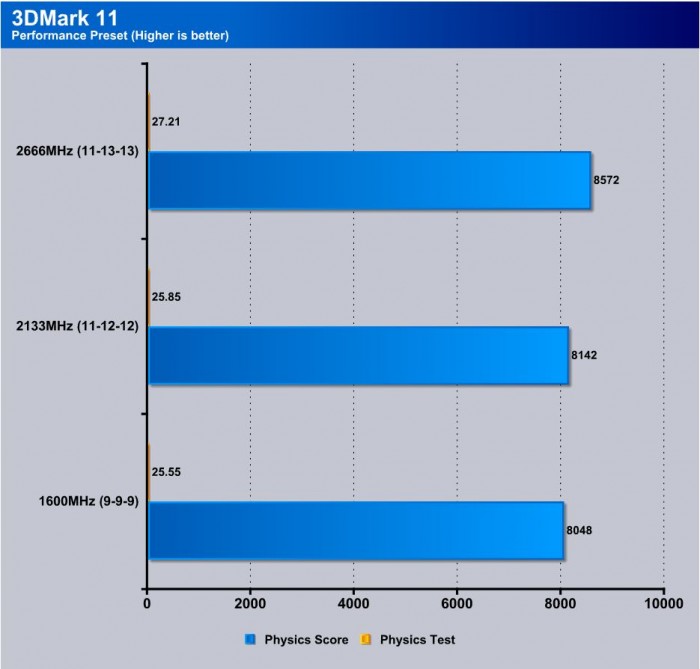Introduction
Gskill has been a popular memory provider for some time and their innovation along with work with high end overclockers helps push them to even more popularity as their memory can be seen at some tof the top benchmarks records in the world. Also the recent Computex show Gskill had a booth setup with overclocking pretty much the entire time with LN2 powered rigs all running Gskill memory just pushing for overclocking world records. The kit we have today is a TridentX model like we have seen before but this model is binned at 2666MHz at nice timings to make for a very capable kit for Z77 based platforms. However being that this kit will be tested on the new Haswell system we will see how it performs on this entirely new platform.
As we have seen before, when you start getting to the higher memory frequencies a higher clockspeed on the CPU is needed to see the increase in performance, which is why these are considered “enthusiast” modules. The new Haswell along with Ivy Bridge platforms are simply so efficient and run so well that pushing a huge memory frequency nets marginal results. To see the full potential of these modules you really do have to overclock the CPU a bit to see them running without a bottleneck slowing them down.
The 8GB kit you see here retails at Newegg for $149.99 at the time of writing, which when compared to other 2x4GB 2666 kits is a bit on the high side as all of the other kits presently listed on the egg are around 129.99 with one kit even hitting the 99 dollar mark from Team Group. This places it in a very interesting spot as we know the quality of Gskill but besides the included cooling fan what does it offer in terms of performance and overclocking that could sway purchasers to it from a lower priced competitor?
Pictures & Impressions
This module kit comes in a brown box as opposed to the blister pack you have seen before. This is likely due to the included fan and the need to give it safe travels. You will notice that it is listed as for Z77 which is good and all but when we got this kit we had expressed emphatically to ensure it works well out of the box with Haswell since that’s what it would be tested on. Since from testing so far the two platforms are quite similar except Haswell has a pretty strong memory controller this kit should be well. Just be mindful that tuning goes into play that allows certain kits to perform better on certain platforms vs another. This kit being CFR IC’s it could go either way when it comes to overclocking.
Here you can see the clip on fan which with DDR3 is not necessarily a needed item but keeping the modules cooler could be a good choice as needed for overclocking potential.
The modules themselves are the standard TridentX black heatspreader with the removable top red fin which helps with fitment on some larger coolers that may be an issue with fitment of a larger tower otherwise. the heatspreaders themselves are rather thick, definitely much more so than some of the stamped thin metal units you see out there so these actually could work to help pull heat off the ICs themselves versus trapping heat within.
| M/B Chipset |
Intel Z77 |
| CAS Latency | 11-13-13-35 |
| Capacity |
8GB (4GB x 4) |
| Speed | DDR3-2666 (PC3 21300) |
| Test Voltage | 1.65 Volts |
| Height | 54 mm / 2.13 inch |
| Registered/Unbuffered | Unbuffered |
| Error Checking | Non-ECC |
| Type | 240-pin DIMM |
| Warranty | Lifetime |
| Features | Intel XMP 1.3 (Extreme Memory Profile) |
These modules as you can see are XMP profiled for 2666MHz with reasonable but slightly looser timings. This will allow much better compatibility and they should have some room to raise speed or tighten up the timings as you push the performance envelope. But this kind of consideration is important as speeds go up as speed rises some chips IMC might not be able to pull off the speed/timing combo.
Testing & Methodology
Memory testing can be tough at times as most look at a number (the frequency) and think the higher the better, but in our testing experience we know that many times there are other numbers at play. Factors such as the timings and subtimings can have anywhere from a minimal to a drastic effect on what kind of performance we see from the system when tweaked to the max. Also price can be a determining factor as well and this is why we will run through a few benchmarks to see how this kit affects system performance running at SPD, XMP and custom tweaking to ensure we get a good idea of exactly what kind of value the end consumer can expect for their money.
Overclocking
One thing to note right off the bat is that anything past 1600MHz-1866MHz will not net you anything on a stock clocked 3770K/4770K. The architecture is just too efficient and therefore the higher memory frequency simply cannot be seen without the CPU moving a bit faster. In order to ensure optimal performance is observed I set the CPU frequency to 4.6GHz. When we tested the memory first at stock speeds the difference between SPD 1600MHz C9 was not there it was a marginal to non existent change no matter the benchmark.
The memory is binned well but definitely loose for what it is as upon pushing a bit with the Haswell rig was able to push up to 2936 MHz which is really good as I just about tapped the 3GHz number for the memory. This was accomplished by simply loosening up the timings to CL12 which is not horrible and the memory went rather well, not it was not 100% 24/7 stable as it took 1.7VDimm to accomplish complete stability but i see this as pretty much for benchmark purposes only when pushing this high. There are no real world gaming or productivity benefits of pushing your memory and IMC this hard in a situation like this, however for those looking for a extra boost of frequency for their record runs as you can see the TridentX can answer the call.
An attempt to tighten up the timings did not net very good results as it seem the IC’s did not want to run any tighter which it could just be my sticks as I have seen these kits able to tighten up quite a bit from other sets of the same model out in the wild and from overclocker friends I had seen use them.
CAUTION: Overclocking can damage components, void warranties and cause all kinds of other unforeseen issues. Perform at your own risk and understand the settings we may list are from our own testing risking my own hardware so it is in no way a guide on how you should overclock your system or components.
Test Rig
| Test Rig | |
| Case | Open Air Test Bench |
| CPU | Intel Core i7-4770K |
| Motherboard | ASRock Z87M-OC Formula |
| RAM | 8GB Gskill F3-2666C11D-8GTXD 2666MHz (2x4GB) |
| CPU Cooler | Swiftech H20-320 Edge HD |
| Hard Drive | Western Digital Velociraptor 300GB |
| SSD | Kingston HyperX 240GB SSD |
| Optical | ASUS BD-ROM |
| GPU | Intel HD 4600 |
| Additional Cards |
N/A |
| PSU | Thermaltake Toughpower XT 1475W Gold |
| Mouse | Tt eSPORTS Theron gaming mouse |
| Keyboard | Tt eSPORTS Meka G1 mechanical gaming keyboard |
Test Suite
We will use the following applications to test the performance of the memory. Benchmarks
| SiSoft Sandra 2011 |
| AIDA64 Extreme |
| Superpi |
| 3DMark 11 |
| Sniper Elite V2 |
SiSoft Sandra 2011
“SiSoftware Sandra (the System Analyzer, Diagnostic and Reporting Assistant) is an information & diagnostic utility. It should provide most of the information (including undocumented) you need to know about your hardware, software and other devices whether hardware or software. It works along the lines of other Windows utilities, however it tries to go beyond them and show you more of what’s really going on. Giving the user the ability to draw comparisons at both a high and low-level. You can get information about the CPU, chipset, video adapter, ports, printers, sound card, memory, network, Windows internals, AGP, PCI, PCI-X, PCIe (PCI Express), database, USB, USB2, 1394/Firewire, etc.”
Here you can see that moving from the 1600MHz SPD to 2133 gives a nice gain, and moving to 2666 XMP setting it simply did not do a whole lot to improve as I said the realistic gains you see will be ion benchmarks where you are calculating the smallest gains in efficiency and that’s where these modules will definitely shine.
AIDA64 Extreme
“AIDA64 Extreme is about one of the most comprehensive system information utilities I have used. The integrated memory benchmark is also very cool as it gives me a repeatable bandwidth and latency result which can then be used for comparison.”
AIDA64 shows similar results as the jump is huge from the SPD default to XMP profile. Latency definitely responds showing it drop rather well from XMP to 2133 to the TridentX and even the write speed takes a nice jump this time as well.
Superpi
Here we have SuperPi which does very well for testing efficiencies and also stability of a platform. The 1M test is the short and dirty test with very minor gains from tweaking memory. However in the long 32M test you can see that the small tweaks in memory can make a pretty big difference in things like render jobs where data will be consistently processed for a long period, it can save you quite a large amount of time depending on the job possibly even minutes which if it is a production system that can save huge money as well by getting work done faster.
3DMARK 11
3DMark 11 is the newest in Futuremark’s suite of benchmarking utilities. Its a fully capable DirectX11 benchmark which also stresses and analyzes the system performance as a whole to simulate a heavy rendering environment such as a high end game or other app the end user may run. This benchmark was run with Performance settings 5 times and all runs were averaged for the result below.
3DMark 11 is a nice synthetic benchmark which represents 3D gameplay. For this we are using the integrated HD4600 running at performance preset and we are only interested in the Physics score and test results. This is a CPU bound test and there is some gains seen by the increases of memory speed and also tightening up the timings where available.
Sniper Elite V2
Sniper Elite V2 is a newer game we just recently added to our testing, so we went ahead and threw it in here just to see if it added any performance in real world gameplay. Much like we have seen before since the iGPU uses the system memory increasing its frequency increases the GPU performance and rightfully so you see a decent gain going from SPD to a 2133 kit to the TridentX with a total gain of over 3FPS.
Our Final Thoughts

The XMP on this kit is strong and most any chip should be able to run it without issue and it will offer a very good advantage versus a budget 1600 kit even with tighter CL9 timings.
The overclocking ability on this kit is quite strong as it almost hit 3K with just a little tweaking which means that the Gskill legacy of performance and overclocking prowess is well in place here and I simply like this kit as it works well although I do have to say that would this kit have been made with MFR based IC’s it could have pushed the 3K barrier and further as these IC’s tend to be very well fitted for work with the Z87/Haswell platform. Being that this kit is marked as Z77 targeted I can understand why it is so, and it still does very well for its placement and i cannot wait to see what a Gskill MFR based kit can do with some strong IC’s.
Overall no matter if you’re a gamer, overclocker or just want to upgrade from some basic low end sticks. The Gskill TridentX Line is super strong and this kit in particular matched with the right platform can get almost 3K and possibly more if put under cold.
| Pros: | Cons |
|
|
Review Overview
Performance - 9.5
Value - 8.5
Quality - 9.5
Features - 9
Innovation - 9
9.1
The Gskill TridentX 2666 8GB Kit has very good overall performance with excellent overclockability, for this it earns the Bjorn3D Golden Bear Award
 Bjorn3D.com Bjorn3d.com – Satisfying Your Daily Tech Cravings Since 1996
Bjorn3D.com Bjorn3d.com – Satisfying Your Daily Tech Cravings Since 1996


